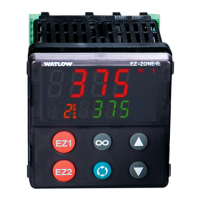Watlow EZ-ZONE
®
PMI Controller • 65 • Chapter 4 Home Page
Note:
With the release of firmware revision 7.00 and above new functions where introduced into
this product line. With the introduction of these new functions there was a reorganization
of Modbus registers. Notice in the column identified as Modbus the reference to Map 1 and
Map 2 registers for each of the various parameters. If the new functions, namely; Math,
Linearization, Process Value, Real Time Clock and the Special Output Function are to be
used than use Map 2 Modbus registers. If the new functions of this product line are not to
be used, Map 1 (legacy PM controls) Modbus registers will be sufficient. The Modbus regis-
ter mapping [map] can be changed in the Setup Page under the CoЛЏ Menu. This setting
will apply across the control. We recommend to use Map 2 for all new applications. Use
Map 1 only if desired to maintain backwards compatibility.
It should also be noted that some of the cells in the Modbus column contain wording pertain-
ing to an offset. Several parameters in the control contain more than one instance; such
as, proles (4), alarms (4), analog inputs (2), etc... The Modbus register shown always rep-
resents instance one. Take for an example the Silence Alarm parameter found in the Setup
Page under the Alarm Menu. Instance one of Map 1 is shown as address 1490 and +50 is iden-
tied as the offset to the next instance. If there was a desire to read or write to instance
3 simply add 100 to 1490 to nd its address, in this case, the instance 3 address for Silence
Alarm is 1590.
The Modbus communications instance can be either 1 or 2 depending on the part number.
Instance 1:
PM _ _ _ _ _ - [1] _ _ _ _ _ _
Instance 2:
PM _ _ _ _ _ - [2] _ _ _ _ _ _
To learn more about the Modbus protocol point your browser to http://www.modbus.org.
Common Industrial Protocol (CIP) Introduction to CIP
Both DeviceNet and EtherNet/IP use open object based programming tools and use the same
addressing scheme. In the following menu pages notice the column header identied as CIP.
There you will nd the Class, Instance and Attribute in hexadecimal, (decimal in parenthesis)
which makes up the addressing for both protocols.
The CIP communications instance will always be instance 2.
Data Types Used with CIP
int = Signed 16-bit integer
uint = Signed 16-bit integer
dint = Signed 32-bits, long
real = Float, IEEE 754 32-bit
string = ASCII, 8 bits per character
sint = Signed 8 bits , byte
To learn more about the DeviceNet and EtherNet/IP protocol point your browser to http://
www.odva.org.
J1939 CAN
This protocol was originally introduced back in the 80s by Robert Bosch and was quickly ad-
opted and incorporated into many new cars. Because of its reliability and wide acceptance,
this protocol is also used heavily within heavy-duty vehicles, e.g., trucks, buses, etc... The
J1939 communications will always be instance 2 as implemented in the EZ-ZONE PM.

